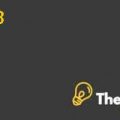
HEDGING CURRENCY RISKS AT AIFS
PROBLEM STATEMENT:
The problem identified in this case is, to determine that which option is best in different scenarios with respect to the fluctuation in exchange rates.
Q1 - What is the cause of currency exposure at AIFS?
Currency exposure or Foreign exchange risk occurs when a transaction is not denominated in the currency of base country but in the currency of different country. It includes financial transaction. Therefore, it is a financial risk. If a foreign subsidiary of a company does not maintain its financial statements in the reporting currency of the parent company then, there is a risk of negative movement in exchange rate which will result in difference between both currencies. Exchange rate risk can have financial impacts but essential steps can be taken to manage and reduce the risk.
Types of Exposure
- Transaction exposure
The transaction exposure also known as a short-term economic exposure is a risk which results due to contracts subjected to foreign exchange exposures in which company has already entered. A transaction exposure can be on buy side or sell side of a business transaction for a company.
- Economic exposure
Economic exposure has a long-term effect of the transaction exposure. A company is believed to have an economic exposure if it is constantly affected by inescapable exposure to foreign exchange over the long-term. These exposures to foreign exchange are integral to the company and affects its profitability over the years and therefore results in an influence on the market value of the company as a risk.
- Currency conversion exposure
Conversion exposure is accounting natured and is known as balance sheet exposure or accounting exposure. It relates to restatement, conversion or translation of the financial statements resulting in gain or loss of a subsidiary located in another country.
Identification of Currency exposure at AIFS
The three types of currency exposures should be identified, classified and maintained with the related time frame and involving foreign currencies. This is vital for management reporting within a company.
The AIFS works in two divisions. One is College division for semester long programs and the second for Boston based high schools travel division. AIFS sends more than 50,000 students each year on cultural and academic exchange programs worldwide. Students have been sent to America, Canada and other countries and are chosen as per their capabilities. AIFS’ business of sending students worldwide, the time difference between when payment was received and when prices were set, has created transaction exposure. A major concern for the company is to sustain a loyal and dedicated customer base by ensuring that prices would not change prior to the release of the subsequent catalog.
Fluctuations in exchange rates can create movements in the cost basis which cannot be passed onto customers. There is a reasonably long lead time between, when prices were set and when the payment was received from students which results in a significant amount of uncertainty regarding the operating cost of AIFS. The potential difference in the yearly volume of students registered in the AIFS programs also results in currency exposure.
Q2 – What would happen if Archer-Lock and Tabaczynski did not hedge at all?
According to the data given in the case, AIFS use to organize programs for students who want to study abroad and also organize the cultural exchange programs. The company has two major divisions those are managed by the Archer-Lock. Tabaczynski, who is the CFO of the study abroad division and the high school travel division, provides finance for these two divisions. Company faces the problem as its revenue is in Dollar denomination and its cost incur is in Euros and British Pounds denominations. These different denomination currency dealing persuade the company to hedge its foreign exchange risks using the different hedging instruments. Tabaczynski uses the currency hedging to secure AIFS’s revenue generating sources and fluctuation of the currency rates. If AIFS would not have gone for hedging then, company had to take full exposure towards the currency risks which would have ultimately resulted in the loss in dollar denominations (if found depreciation in the US dollar). On the other hand, it can also gain the profit if the USD appreciates. In reality, future is unpredictable and the sales volume of the company cannot be predicted accurately and it goes same with the exchange rates. If any of these two variables depreciate in near future than the company would be in loss of millions of dollars. By doing this, the cost would also increase tremendously which would result large amount of funds into costing. For example, company expects 25,000 students to enroll in their program per year, and if the USD exchanges rates declines to 1.01 per Euro than the company could benefit in terms of increase in revenues of about $5.25 million. However, if the USD exchange rates decline against the Euro currency to USD1.48/Euro, than it would result in loss of USD 6.5 million.................................
This is just a sample partial case solution. Please place the order on the website to order your own originally done case solution.
The American Language Institute (AIFS) organizes study abroad programs and cultural exchanges for American students. The firm's revenues are mainly in U.S. dollars, but most of their expenses in Eurodollars, and the British pound. Controllers company revised hedging activities AIFS. AIFS has a hedging policy, but the controllers want to revise the interest rate risk, which is covered and the use of forward contracts and options. AIFS sets guaranteed prices for their exchanges and tours for the year ahead, to its final sales figures are known. Controllers must ensure that the company adequately hedge its currency risk, and provides an appropriate balance between forward contracts and currency options. For an executable tables (courses), please contact our customer service department at custserv@hbsp.harvard.edu. "Hide
by Mihir A. Desai, Anders Sjoman, Vincent Dessain Source: HBS Premier Case Collection 17 pages. Publication Date: September 8, 2004. Prod. #: 205026-PDF-ENG










